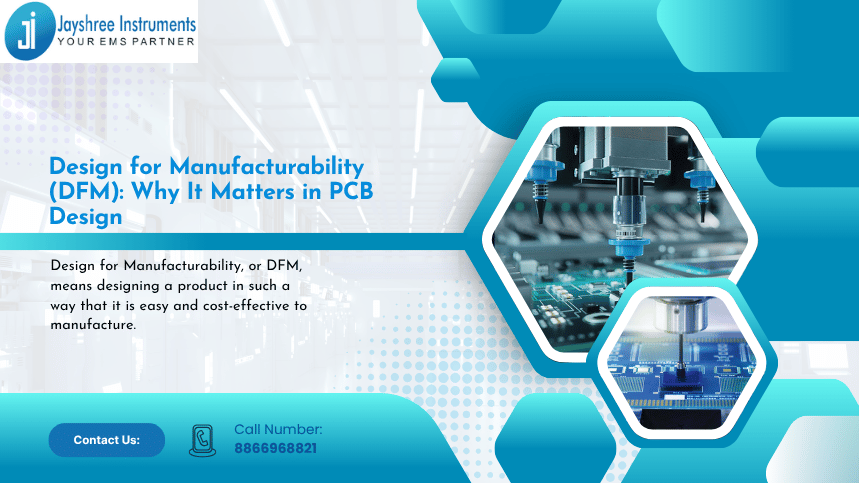In today’s electronics world, making products quickly, efficiently, and without errors is very important. One key step in this process is designing the printed circuit board (PCB) properly. The PCB is the heart of any electronic device, connecting all the components and making sure everything works smoothly. When PCB design is done with care and thought, it can help reduce costs, speed up production, and improve product quality. This is where the concept of Design for Manufacturability (DFM) comes into play. If you are looking for expert help in this area, choosing professional PCB design services India can make a huge difference.
What is Design for Manufacturability (DFM)?
Design for Manufacturability, or DFM, means designing a product in such a way that it is easy and cost-effective to manufacture. It involves thinking about the manufacturing process right from the design stage. When a PCB is designed with DFM in mind, it helps avoid problems later during production. This approach also helps in faster time-to-market and fewer design changes.
Why PCB Design is So Important in DFM
-
Reduces Manufacturing Errors
One of the biggest advantages of good PCB design is that it helps avoid mistakes during the manufacturing process. If a PCB is not designed properly, it can lead to short circuits, broken connections, or component fitting issues. All of these problems can delay production and increase costs. By applying DFM rules during the design stage, you can make sure the PCB is easy to build and works well.
-
Saves Time and Money
When errors are caught early in the design stage, it saves a lot of time and money. Fixing problems after production begins is not only expensive but can also slow down delivery to customers. A DFM-friendly PCB design ensures that everything fits correctly, and the board can be produced using standard tools and processes. This reduces the chances of rework and costly changes later.
-
Improves Product Reliability
A well-designed PCB means a more reliable product. If the layout is clean, and the components are placed correctly, the board is less likely to fail during use. DFM helps ensure that all parts of the PCB are placed with enough space, are not too close to the edges, and can handle the heat and power they receive. This leads to products that last longer and perform better.
-
Simplifies Testing and Inspection
Testing a PCB is easier when it is designed with DFM in mind. Features like test points, easy-to-access connections, and clear labeling can make inspection faster and more accurate. This helps in identifying problems early and ensures the final product meets quality standards. It also makes repairs easier if something goes wrong.
-
Helps in Mass Production
Mass production of electronic devices requires boards that are consistent and easy to assemble. When PCB design follows DFM rules, it makes automated assembly easier. This includes proper spacing for machines to place parts, correct hole sizes, and avoiding sharp angles or difficult shapes. Such design choices make sure that the boards can be produced in large numbers without issues.
Key DFM Guidelines in PCB Design
Here are some simple DFM guidelines that can help improve your PCB design:
- Use standard component sizes: This helps in sourcing parts easily and reduces cost.
- Keep trace widths consistent: This ensures proper current flow and avoids overheating.
- Place components with enough space: Avoids crowding and makes assembly simpler.
- Avoid sharp corners in traces: Rounded corners are better for signal flow.
- Use clear labels and markings: Helps during testing and troubleshooting.
- Design for thermal management: Ensures the board doesn’t overheat.
The Role of Experts in DFM-Friendly PCB Design
While basic DFM rules can be followed by anyone, having experts handle your PCB design adds a lot of value. Professionals know the fine details of what works and what doesn’t in real-world manufacturing. They also stay updated with industry standards and use advanced tools to create designs that are accurate and efficient. Hiring experienced teams for PCB design services in India ensures that your project is in safe hands from the beginning.
Conclusion
Designing a PCB is not just about connecting components but about doing it in a way that makes production smooth and cost-effective. By following the principles of Design for Manufacturability, companies can create better products, avoid costly mistakes, and reach the market faster.
If you’re planning to bring an electronic product to life, make sure you partner with a team that understands both design and manufacturing. Choosing the right PCB design services in India can help you get a strong start. And when it comes to building and assembling your final product, don’t forget the importance of reliable PCB assembly services because a great design deserves great execution.

Recent Comments